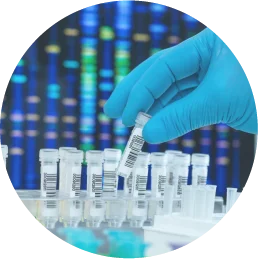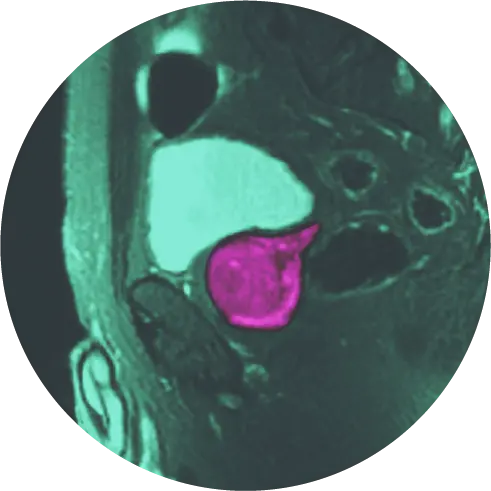As our bodies age, it is important to keep up with our changing health needs and prioritize preventive care. For men, prostate cancer is the second-most common cancer diagnosed in the U.S. and one of the leading causes of death among men of all races, all over the world.1 Prostate cancer may not produce any early symptoms, yet it’s highly treatable if found in the beginning stages before it can spread. Therefore, knowing the facts and adhering to a prostate screening routine is crucial.
The decision about when to start screening for prostate cancer should be made between the patient and his doctor after discussing individual risk factors and health status. For example, men with less than a 10-year life expectancy would generally not benefit from testing. It is important to note that testing comes with certain risks and uncertainties.
The American Cancer Society recommends the following ages to discuss the risks and benefits of prostate cancer screening:
- Age 50 – men who are at average risk of prostate cancer and are expected to live more than 10 years
- Age 45 – men at high risk of developing prostate cancer
- Age 40 – men at an even higher risk of developing prostate cancer2
After this discussion, men should follow their doctor’s recommendations of when and how to begin screening. More information about various screening methods for prostate cancer can be found in the following sections of this article.
What is Involved in a Prostate Screening?
Screening tests are used to detect cancer in people before they exhibit symptoms—when treatment is likely to be the most effective. Although a screening can yield findings that indicate possible cancer, a prostate biopsy must be performed to determine for certain whether there is cancer present.
Prostate-Specific Antigen (PSA) Testing
PSA is a protein made by cells in the prostate gland. Although PSA is mostly found in semen, a small amount is also found in blood. PSA is produced by both normal prostate cells and prostate cancer cells. Therefore, if PSA levels are increasing, it suggests that cancer cells are adding to the production of PSA.
There is no set “level” that indicates a man definitely does or doesn’t have cancer. Many doctors use a cutoff point of 4 ng/mL or higher to indicate the need for further testing; most men without prostate cancer have a level below 4.
Figure 1: PSA levels and cancer risk (Source: American Cancer Society)3
| PSA level | Indication |
| Less than 4 ng/mL | Likely normal, however a small percentage of men with a PSA below 4 will have prostate cancer if a biopsy is done. |
| Between 4 and 10 ng/mL | Considered the “borderline range.” Men have about a 1 in 4 chance of having prostate cancer. Further testing is indicated. |
| Greater than 10 ng/mL | The chance of having prostate cancer is high, at over 50% of men with these results. Further testing is indicated. |
One reason the cutoff points for PSA levels are somewhat vague is because there are other non-cancerous factors that can cause PSA levels to increase or decrease:
Non-cancer factors that may increase PSA levels:
- An enlarged prostate, which is common in older men. This condition is called benign prostatic hyperplasia (BPH).
- Older age; PSA levels normally go up slowly as men get older, even with no prostate abnormalities.
- Prostatitis, which is an infection or inflammation of the prostate can temporarily increase PSA levels.
- Ejaculation can make the PSA level go up for a short time. It is recommended to refrain for a day or two before testing.
- Riding a bicycle may put pressure on the prostate and raise PSA levels for a short time.
Factors that may decrease PSA levels:
- Certain drugs used to treat BPH or urinary symptoms.
- Herbal mixtures and dietary supplements can mask high PSA levels. It is important to include these in the medication list for your doctor.
- Other medications such as aspirin, cholesterol-lowering drugs, and thiazide diuretics might lower PSA levels.
If screening results don’t indicate the presence of prostate cancer, the time between future screenings depends on PSA results. Men who have a PSA level less than 2.5 ng/mL may only need to be retested every 2 years. Men who have a PSA level of 2.5ng/mL or higher may need to be retested every year.
Digital Rectal Exam (DRE)
This is the test that many men tend to avoid out of embarrassment or discomfort with the procedure. Not all doctors still do DRE, since it is less effective at finding cancer than the PSA test. However, it has been found that sometimes a digital rectal exam can find abnormalities that a PSA test can’t detect yet.
Research shows that prostate cancers often begin in the back part of the prostate gland, located just in front of the rectum. For this reason, lumps or enlargement can sometimes be felt during a rectal exam. The physician inserts a gloved, lubricated finger into the rectum to feel for bumps or hard areas that might need further testing. The exam is short and usually slightly uncomfortable but not painful.
What If My PSA Is Higher or They Find Something?
Further testing will be needed to determine if, in fact, you have cancer. Many men with elevated PSAs will receive a non-cancer explanation after additional testing. Depending on your age, overall health, and other risk factors, your doctor may suggest:
- Waiting a few weeks and having a second PSA test
- Getting another type of test (there are multiple types of PSA tests)
- An imaging test of the prostate gland, such as an MRI or trans-rectal ultrasound (TRUS)
- Getting a prostate biopsy to find out if you have cancer
- Receiving a urine test for signs of prostate cancer in the urine
Am I High Risk?
All men are at some risk for prostate cancer. Statistically, about 13 out of every 100 American men will get prostate cancer during their lifetime. However, there are some factors that place men in a higher-risk group—namely genetics, lifestyle, environment and race.4
Genetics Can Put You at a Higher Risk for Prostate Cancer
Approximately 5-10% of prostate cancer cases are believed to be caused by a genetic predisposition, specifically changes in the BRCA1, BRCA2, HOXB13, or several other genes.5 Another 10-20% of all cancers are “familial,” meaning they occur in multiple family members but are not tied to a specific gene. If you meet any of the following conditions, you are at a higher risk for prostate cancer:
- One or more first-degree relatives (father, son, or brother) have had prostate cancer
- Other members of your family have been diagnosed with breast, ovarian, or pancreatic cancer
- Members of your family were diagnosed with prostate cancer before age 55
This history should prompt a discussion with your physician about whether or not you should undergo genetic testing to find out the exact genetic mutations you may have. A known familial cancer trend should prompt your physician to start screenings earlier and perhaps more frequently.
As a part of our commitment to early disease detection and saving lives, we recently introduced the HALO PathWay™ for Prostate. By combining advanced imaging and hereditary cancer genetic testing, HALO is able provide you with a clear and detailed picture of your health. Please visit the following link to learn more about the HALO PathWay.
Lifestyle and Environment Can Put You at a Higher Risk for Prostate Cancer
Current research suggests some dietary connection to an increased prostate cancer risk. Some studies suggest that diets high in animal fats may increase risk, and that a diet high in fruits, vegetables, and legumes may lower risk. None of these statements are considered conclusive yet and require further study. It is, however, a known fact that obesity is associated with many cancers, including prostate cancer.6 No specific vitamins, minerals, or supplements have been associated with lowering risk.
Men who have been exposed to Agent Orange, a chemical used during the Vietnam War, are considered to be at a high risk for prostate cancer, as confirmed by the U.S. Department of Veteran Affairs. Exposed men have about a 50% higher risk for getting prostate cancer and for developing a more aggressive form of it.7
Race Can Put You at a Higher Risk for Prostate Cancer
Black men in the U.S. and other men of African descent are diagnosed with prostate cancer more than other races and at younger ages. The incidence of prostate cancer in Black men is almost 60% higher, and mortality is 2-3 times higher than in Caucasian men. Native American men have the second highest risk for prostate cancer. It is also known that men of Ashkenazi Jewish ancestry are at higher risk. These increased risks are attributed to genetic factors as well as some health access disparities, however more study is needed.8
Many groups and physicians advocate for early PSA screening, beginning at age 40, for Black men and other racial groups at high risk.
Talk to Your Doctor to Begin Prostate Cancer Screening
Discuss prostate cancer screening with your doctor to understand the risks and benefits. Your doctor will help you understand your level of risk and balance it with your concerns for your health.
Some physicians will recommend genetic testing to help quantify prostate cancer risk specific to you. Genetic testing can give us a wealth of information to be used in different ways. Genetic mutations can be passed from father to son, father to daughter, mother to daughter, and mother to son.
Knowing if you and other members of your family have mutations linked to higher risk of cancer can guide decision-making for not just early screening of prostate cancers, but also breast and ovarian, colorectal, and pancreatic cancers.
If you have received a high-PSA test result and you’re interested in additional diagnostic tests, contact us for more information. If you have received a prostate cancer diagnosis, contact us to learn more about minimally invasive prostate cancer therapy with a lower risk of side-effects.
HALO is Here to Help
At HALO Precision Diagnostics, we realize that every patient is unique and so are their prostate concerns. To learn more about scheduling a PSA test at one of our centers or to learn more about our minimally invasive prostate cancer treatments, please schedule a consultation with one of our experts today.
References
- Centers for Disease Control and Prevention. (2022). Prostate Cancer Statistics. Division of Cancer Prevention and Control, CDC. Retrieved 21 December 2022 from: https://www.cdc.gov/cancer/prostate/statistics/index.htm
- American Cancer Society Recommendations for Prostate Cancer Early Detection. (2022). Retrieved 21 December 2022, from https://www.cancer.org/cancer/prostate-cancer/detection-diagnosis-staging/acs-recommendations.html
- American Cancer Society. (2022). Prostate Cancer Screening Tests. Retrieved 21 December 2022, from: https://www.cancer.org/cancer/prostate-cancer/detection-diagnosis-staging/tests.html
- Centers for Disease Control and Prevention. (2022). Who is at Risk for Prostate Cancer?. Division of Cancer Prevention and Control, CDC. Retrieved 21 December 2022 from: https://www.cdc.gov/cancer/prostate/basic_info/risk_factors.htm
- National Institute of Health. (2022) Familial Prostate Cancer. Genetic and Rare Diseases Information Center. Retrieved 21 December 2022, from: https://rarediseases.info.nih.gov/diseases/4520/familial-prostate-cancer
- https://www.cancer.org/healthy/cancer-causes/diet-physical-activity/diet-and-physical-activity.html
- Chamie, K., DeVere White, R. W., Lee, D., Ok, J. H., & Ellison, L. M. (2008). Agent Orange exposure, Vietnam War veterans, and the risk of prostate cancer. Cancer, 113(9), 2464–2470. https://doi.org/10.1002/cncr.23695
- Lowder, D., Rizwan, K., McColl, C., Paparella, A., Ittmann, M., Mitsiades, N., & Kaochar, S. (2022). Racial disparities in prostate cancer: A complex interplay between socioeconomic inequities and genomics. Cancer letters, 531, 71–82. https://doi.org/10.1016/j.canlet.2022.01.028




